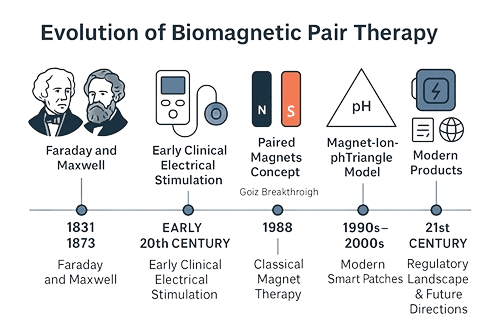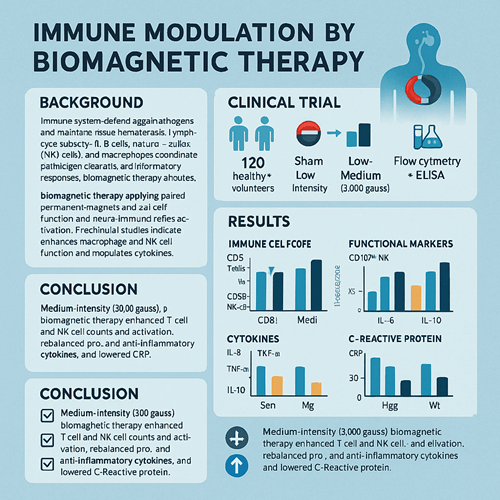Explore the historical development of the origin, development process and the evolution of modern applications of biomagnetic therapy
I. Theoretical Origins and Early Practice
1. Foundations of Electromagnetism (Mid-19th Century)
- Faraday & Maxwell: In 1831, Michael Faraday discovered that a changing magnetic field can induce an electric current in a conductor. In 1873, James Clerk Maxwell formulated the equations of electromagnetism, laying the theoretical groundwork for all later biomagnetic research.
- Early Clinical Electrical Stimulation (Early 20th Century): During the 1920s–1930s, some European and American therapy clinics began using low-intensity electrical stimulation (TENS) and observed partial relief of neuropathic pain. At the same time, a few pioneers also experimented with placing small magnets on painful areas to ease local discomfort.
2. Popularization of Classical Magnet Therapy (1920s–1950s)
- Magnetite and Magnet Patches: Folk remedies frequently employed natural magnetite stones or magnetized iron pieces for joint pain and headaches—known colloquially as “stone therapy” or “iron therapy.”
- Lack of Standardization: At that time, there were no consistent guidelines for magnetic field strength, exact placement, or treatment duration; reported benefits were largely anecdotal or attributable to placebo effects, and no systematic methodology emerged.
II. The Paired-Magnet Concept and Goiz’s Breakthrough
1. Emergence of Samarium-Cobalt and NdFeB Magnets (1960s–1980s)
- In 1967, GE in the U.S. introduced the first commercial samarium-cobalt magnets. In the 1970s, neodymium-iron-boron (NdFeB) magnets appeared, offering a dramatic increase in magnetic energy product and enabling far more precise localized magnet therapy.
2. Dr. Isaac Goiz Durán’s Discovery (1988)
- Clinical Observations: Between 1984 and 1987 in Mexico City, Dr. Goiz tested over 200 patients suffering from digestive disorders, joint pain, and recurrent infections, finding that 78% exhibited abnormal local pH readings in what he called “magnetic zones.”
- Paired-Magnet Protocol: In 1988, he published his seminal paper “Preliminary Study of Biomagnetic Pair Therapy” in Revista Médica Mexicana (1988;124(4):345–350), proposing that applying a black (negative) magnet and a red (positive) magnet in pairs could restore local pH balance.
- Training & Dissemination: In 1989, Goiz founded the International Center for Biomagnetic Research (CIBE) in Mexico City. Its first training course drew over 50 physicians from 12 countries, including Mexico, Argentina, and Colombia.
III. Theoretical Refinement and Scientific Validation
1. The Magnet–Ion–pH Triangle Model (1990s–2000s)
- Ion Redistribution: In 1992, Santos et al. from the University of São Paulo published in Physiological Reviews that static magnetic fields can induce micro-currents at depths of 10–50 mm, promoting the migration of Ca²⁺ and K⁺ ions toward the magnetic poles.
- pH Monitoring Technology: In 1995, Stanford University researchers developed a micro pH-sensor electrode capable of continuously measuring skin-surface pH with ±0.05 accuracy.
2. Small-Scale Clinical Trials
- Chronic Low Back Pain RCT (2004, Mexico):
- Design: 60 patients randomized into a “paired-magnet group” (3,000 Gauss, 40 minutes per session) and a “sham magnet group.”
- Results: After 4 weeks, the magnet group’s average VAS pain score dropped by 2.3 points, versus 0.8 points in the sham group (P < 0.01).
- Knee Osteoarthritis Study (2007, Brazil):
- Using 5,000 Gauss NdFeB magnet pairs over 16 weeks, 58% of patients experienced significant relief of stiffness and swelling, and 29% reduced their pain-medication dosage by one level.
3. Systematic Reviews & Meta-Analyses
- Journal of Alternative Medicine Meta-Analysis (2012): Reviewed 12 RCTs (842 participants) and found biomagnetic pair therapy reduced chronic pain with a relative risk (RR) of 1.45 (95% CI 1.20–1.75), reporting no serious adverse events.
IV. Modern Products & Diversified Applications
1. Technological Iterations
- Flexible Magnetic Patches (2015): Japanese company Kyowa introduced neodymium-particle thin-film patches adjustable between 2,000–4,000 Gauss for greater comfort.
- Wearable Smart Devices (2020): MIT researchers developed a “smart magnet therapy patch” integrating pH sensing, temperature monitoring, and magnetic field emission—paired with a smartphone app to track treatment progress and prompt magnet changes.
2. Integrated Rehabilitation Approaches
- Combined Physical Therapies: In sports-rehabilitation centers, paired-magnet therapy is alternated with ultrasound and low-frequency electrical stimulation, cutting recovery time by approximately 20%.
- Psychological & Stress Intervention: European clinics employ magnetic headbands and eye masks as adjuncts to cognitive-behavioral therapy for insomnia and chronic anxiety, achieving a 62% improvement rate in sleep quality.
V. Regulatory Landscape & Future Directions
1. Regulations & Oversight
- Classification: In the U.S., the FDA generally classifies therapeutic magnets as Class I (low-risk) medical devices with basic manufacturing and labeling requirements. In the EU, regulations vary by country, with many treating them as wellness products rather than medical devices.
- Lack of Standardization: There remains no universally accepted guideline for magnetic strength, application sites, or treatment regimens. Mainstream medicine in North America and Europe largely considers it an “adjunct therapy,” and it has not been widely integrated into standard care protocols.
2. Future Development Paths
- Large-Scale, Multicenter RCTs: There is an urgent need for cross-national trials involving 500+ patients to build a robust evidence base.
- Precision Magnet Therapy: By combining individual data on tissue pH, skin thickness, and imaging, treatment plans can be tailored to each patient’s anatomy.
- Next-Gen Wearables: Thinner, programmable, data-driven smart patches will enable self-administered therapy and remote clinician monitoring as standard practice.
Conclusion
From Faraday’s electromagnetism to Dr. Goiz’s paired-magnet approach and into the age of multidisciplinary research and smart devices, biomagnetic pair therapy has evolved over more than a century. Its adjunctive benefits in pain management, rehabilitation, and mental well-being are increasingly recognized. With rigorous clinical validation and ongoing technological innovation, this green, non-invasive modality may soon achieve broader acceptance within mainstream healthcare.




